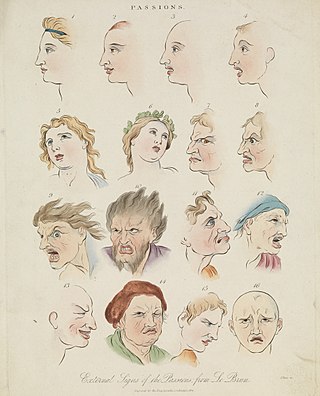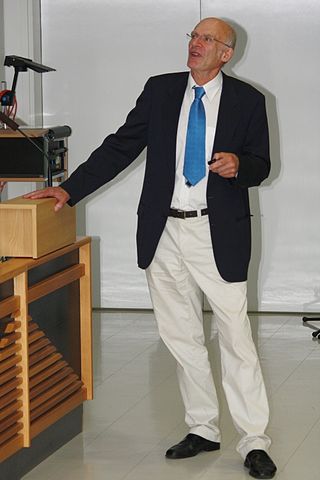Related Research Articles

Emotions are mental states brought on by neurophysiological changes, variously associated with thoughts, feelings, behavioral responses, and a degree of pleasure or displeasure. There is currently no scientific consensus on a definition. Emotions are often intertwined with mood, temperament, personality, disposition, or creativity.
Psychophysiology is the branch of psychology that is concerned with the physiological bases of psychological processes. While psychophysiology was a general broad field of research in the 1960s and 1970s, it has now become quite specialized, based on methods, topic of studies and scientific traditions. Methods vary as combinations of electrophysiological methods, neuroimaging, and neurochemistry. Topics have branched into subspecializations such as social, sport, cognitive, cardiovascular, clinical and other branches of psychophysiology.

Biofeedback is the process of gaining greater awareness of many physiological functions of one's own body by using electronic or other instruments, and with a goal of being able to manipulate the body's systems at will. Humans conduct biofeedback naturally all the time, at varied levels of consciousness and intentionality. Biofeedback and the biofeedback loop can also be thought of as self-regulation. Some of the processes that can be controlled include brainwaves, muscle tone, skin conductance, heart rate and pain perception.
Physiological psychology is a subdivision of behavioral neuroscience that studies the neural mechanisms of perception and behavior through direct manipulation of the brains of nonhuman animal subjects in controlled experiments. This field of psychology takes an empirical and practical approach when studying the brain and human behavior. Most scientists in this field believe that the mind is a phenomenon that stems from the nervous system. By studying and gaining knowledge about the mechanisms of the nervous system, physiological psychologists can uncover many truths about human behavior. Unlike other subdivisions within biological psychology, the main focus of psychological research is the development of theories that describe brain-behavior relationships.

An event-related potential (ERP) is the measured brain response that is the direct result of a specific sensory, cognitive, or motor event. More formally, it is any stereotyped electrophysiological response to a stimulus. The study of the brain in this way provides a noninvasive means of evaluating brain functioning.

Emotional reasoning is a cognitive process by which an individual concludes that their emotional reaction proves something is true, despite contrary empirical evidence. Emotional reasoning creates an 'emotional truth', which may be in direct conflict with the inverse 'perceptional truth'. It can create feelings of anxiety, fear, and apprehension in existing stressful situations, and as such, is often associated with or triggered by panic disorder or anxiety disorder. For example, even though a spouse has shown only devotion, a person using emotional reasoning might conclude, "I know my spouse is being unfaithful because I feel jealous."

The somatic marker hypothesis, formulated by Antonio Damasio and associated researchers, proposes that emotional processes guide behavior, particularly decision-making.
An emotional expression is a behavior that communicates an emotional state or attitude. It can be verbal or nonverbal, and can occur with or without self-awareness. Emotional expressions include facial movements like smiling or scowling, simple behaviors like crying, laughing, or saying "thank you," and more complex behaviors like writing a letter or giving a gift. Individuals have some conscious control of their emotional expressions; however, they need not have conscious awareness of their emotional or affective state in order to express emotion.

Affective neuroscience is the study of how the brain processes emotions. This field combines neuroscience with the psychological study of personality, emotion, and mood. The basis of emotions and what emotions are remains an issue of debate within the field of affective neuroscience.

Affect, in psychology, refers to the underlying experience of feeling, emotion or mood.

Risto Kalervo Näätänen is a psychological scientist, pioneer in the field of cognitive neuroscience, and known worldwide as one of the discoverers of the electrophysiological mismatch negativity. He has been a much-cited social scientist and one of the few individuals appointed permanent Academy Professor of the Academy of Finland. He retired in 2007, retaining a title of Academy Professor emeritus of the Academy of Finland. Since 2007, he has been a professor at the University of Tartu.
In recent years, the use of biologically inspired methods such as the evolutionary algorithm have been increasingly employed to solve and analyze complex computational problems. BELBIC is one such controller which is proposed by Caro Lucas, Danial Shahmirzadi and Nima Sheikholeslami and adopts the network model developed by Moren and Balkenius to mimic those parts of the brain which are known to produce emotion.
Emotional self-regulation or emotion regulation is the ability to respond to the ongoing demands of experience with the range of emotions in a manner that is socially tolerable and sufficiently flexible to permit spontaneous reactions as well as the ability to delay spontaneous reactions as needed. It can also be defined as extrinsic and intrinsic processes responsible for monitoring, evaluating, and modifying emotional reactions. Emotional self-regulation belongs to the broader set of emotion regulation processes, which includes both the regulation of one's own feelings and the regulation of other people's feelings.
In neuroscience, the N100 or N1 is a large, negative-going evoked potential measured by electroencephalography ; it peaks in adults between 80 and 120 milliseconds after the onset of a stimulus, and is distributed mostly over the fronto-central region of the scalp. It is elicited by any unpredictable stimulus in the absence of task demands. It is often referred to with the following P200 evoked potential as the "N100-P200" or "N1-P2" complex. While most research focuses on auditory stimuli, the N100 also occurs for visual, olfactory, heat, pain, balance, respiration blocking, and somatosensory stimuli.
Excitation-transfer theory purports that residual excitation from one stimulus will amplify the excitatory response to another stimulus, though the hedonic valences of the stimuli may differ. The excitation-transfer process is not limited to a single emotion. For example, when watching a movie, a viewer may be angered by seeing the hero wronged by the villain, but this initial excitation may intensify the viewer's pleasure in witnessing the villain's punishment later. Thus, although the excitation from the original stimulus of seeing the hero wronged was cognitively accessed as anger, the excitation after the second stimulus of seeing the villain punished is cognitively assessed as pleasure, though part of the excitation from the second stimulus is residual from the first.
However, the excitation-transfer process requires the presence of three conditions. One: the second stimulus occurs before the complete decay of residual excitation from the first stimulus. Two: there is the misattribution of excitation, that is, after exposure to the second stimulus, the individual experiencing the excitation attributes full excitation to the second stimulus. Three: the individual has not reached an excitatory threshold before exposure to the second stimulus.

The visual N1 is a visual evoked potential, a type of event-related electrical potential (ERP), that is produced in the brain and recorded on the scalp. The N1 is so named to reflect the polarity and typical timing of the component. The "N" indicates that the polarity of the component is negative with respect to an average mastoid reference. The "1" originally indicated that it was the first negative-going component, but it now better indexes the typical peak of this component, which is around 150 to 200 milliseconds post-stimulus. The N1 deflection may be detected at most recording sites, including the occipital, parietal, central, and frontal electrode sites. Although, the visual N1 is widely distributed over the entire scalp, it peaks earlier over frontal than posterior regions of the scalp, suggestive of distinct neural and/or cognitive correlates. The N1 is elicited by visual stimuli, and is part of the visual evoked potential – a series of voltage deflections observed in response to visual onsets, offsets, and changes. Both the right and left hemispheres generate an N1, but the laterality of the N1 depends on whether a stimulus is presented centrally, laterally, or bilaterally. When a stimulus is presented centrally, the N1 is bilateral. When presented laterally, the N1 is larger, earlier, and contralateral to the visual field of the stimulus. When two visual stimuli are presented, one in each visual field, the N1 is bilateral. In the latter case, the N1's asymmetrical skewedness is modulated by attention. Additionally, its amplitude is influenced by selective attention, and thus it has been used to study a variety of attentional processes.
The N170 is a component of the event-related potential (ERP) that reflects the neural processing of faces, familiar objects or words. Furthermore, the N170 is modulated by prediction error processes.
The oddball paradigm is an experimental design used within psychology research. Presentations of sequences of repetitive stimuli are infrequently interrupted by a deviant stimulus. The reaction of the participant to this "oddball" stimulus is recorded.
In neuroimaging, steady state topography (SST) is a methodology for observing and measuring human brain activity that was first described by Richard Silberstein and co-workers in 1990. While SST has been principally used as a cognitive neuroscience research methodology, it has also found commercial application in the field of neuromarketing and consumer neuroscience in such areas as brand communication, media research and entertainment.

Chingis A. Izmailov was a Russian psychophysiologist and psychophysicist, the principal author of the spherical model of color space.
References
- ↑ Johnston, Victor Samuel (1967). "The effects of mescaline analogues on the operant behaviour of rats".
{{cite journal}}: Cite journal requires|journal=(help)